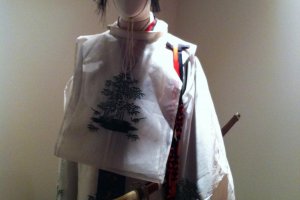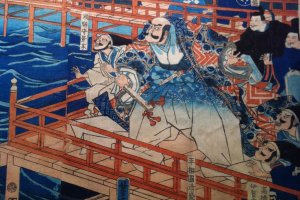After a thorough look at Itsukushima Shrine and a pleasant lunch at Kiyomori-Chaya on the beach area behind the shrine, I headed up through the town towards Mt. Misen. On a quiet back street, I passed an elderly lady swathed in red blankets being pulled on a rickshaw by a young woman in traditional attire.
Further up the street I came upon an attractive old building with a high and ornate wooden fence round it. Sitting in a gateway was a curator sort of gentleman, and beyond him was a beautiful garden. “What is this place?”, I asked him. “This is the Miyajima Museum of History and Folklore (宮島歴史民俗資料館)”, he said beaming, “The entrance is round the corner.”
Entry to the museum is 300 yen for adults. The first exhibit is a rickshaw from the days when they were a regular means of transport. It’s rather grand with its red armchair.
The building itself was once home to a wealthy soy sauce merchant. It’s built of thick, dark wooden beams, with plastered walls in between. Corridors of beaten earth lead between islands of tatami matting, where old furniture and the necessities of commerce such as enormous iron safes are displayed.
There are numerous rooms arranged around a pretty inner garden. Each of the rooms has a different theme. These include the common tools and articles used by Miyajima’s inhabitants in their daily life such as baths, huge saws, and jars for storing water; works of art and artifacts relating to Itsukushima Shrine and its festivals; tools used for carving wood, and the various products that wood used to provide; and a brief history of the little cakes that are popular on Miyajima, the momiji manju. All of these exhibits have explanations in more or less comprehensible English. These exhibits are all dusty, old and charming.
Another section of the museum is newer with more sophisticated presentation. There’s a video explanation of Miyajima and its famous structures in Japanese, although it’s easy enough to understand. Miyajima was recently the subject of a historical drama about Taira no Kiyomori who built Itsukushima Shrine, and there are many artifacts from the drama on display. This section and a room upstairs also feature a large number of attractive and dramatic hanga wood block prints and maps.
It’s easy to spend an hour or more poring over the exhibits and enjoying the atmosphere garden.
































